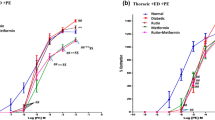Abstract.
The objective of this study was to evaluate whether administration of L-arginine, the substrate for nitric oxide synthesis, was able to ameliorate the endothelial dysfunction and the morphological changes induced by the combined insult of hyperlipemia and hyperglycemia. To this purpose, golden Syrian hamsters were rendered simultaneously hyperlipemic and diabetic (HD group) for 24 weeks, and then orally treated with 622.14 mg/kg per day L-arginine, for 12 weeks (HD + L-arg group). The following assays were carried out: (1) spectrophotometric: concentrations of circulating glucose, cholesterol, and creatinine, the activity of angiotensin-converting enzyme (ACE), and the osmotic fragility of erythrocyte plasmalemma; (2) myographic: the endothelium-dependent and -independent relaxation of the resistance arteries (i.d. 210–250 µm) to 10–8 to 10–4 M acetylcholine (ACh) or sodium nitroprusside (SNP); and (3) electron-microscopic: the ultrastructure of the resistance arteries, myocardium, and kidney glomeruli, which are main targets of hypertensive complications.The results showed that oral supplementation with L-arginine in simultaneous hyperlipemia-hyperglycemia induced in hamsters had favorable effects on: (1) homeostasis, i.e., diminished the concentration of circulating glucose (by ~63%) and cholesterol (by ~10%), reduced the ACE activity (by ~45%), and lowered the osmotic fragility of erythrocyte plasmalemma (as marker for the oxidative stress in plasma); (2) mesenteric resistance arteries, which showed (in 10–4 M ACh) an improved endothelium-dependent relaxation (72.40±4.6% in the HD + L-arg group vs 61.90±1.45% in the HD group) and a reduced thickness (~1.32-fold) of the smooth muscle cells' extracellular matrix; and (3) the heart, which displayed ~16% diminishment of the thickness of the left ventricular wall, and an apparently normal structure of the myocardium; the restoration of the thickness of the pericapillary extracellular matrix to almost normal dimensions was also observed. Administration of L-arginine did not modify the high level of plasma creatinine determined for the HD group (~48% increased vs control group) and had no effect on the thickened, nodular basal lamina of the kidney capillaries. The results indicate that endothelial dysfunction established in combined hyperlipemia-diabetes is distinctive for each vascular bed (mesenteric arterioles, heart capillaries, kidney glomerular capillaries), and there is a reversible stage of the dysfunction in which L-arginine oral supplementation induced beneficial effects.
Similar content being viewed by others
Author information
Authors and Affiliations
Additional information
Electronic Publication
Rights and permissions
About this article
Cite this article
Popov, D., Costache, G., Georgescu, A. et al. Beneficial effects of L-arginine supplementation in experimental hyperlipemia-hyperglycemia in the hamster. Cell Tissue Res 308, 109–120 (2002). https://doi.org/10.1007/s00441-001-0509-4
Received:
Accepted:
Issue Date:
DOI: https://doi.org/10.1007/s00441-001-0509-4




